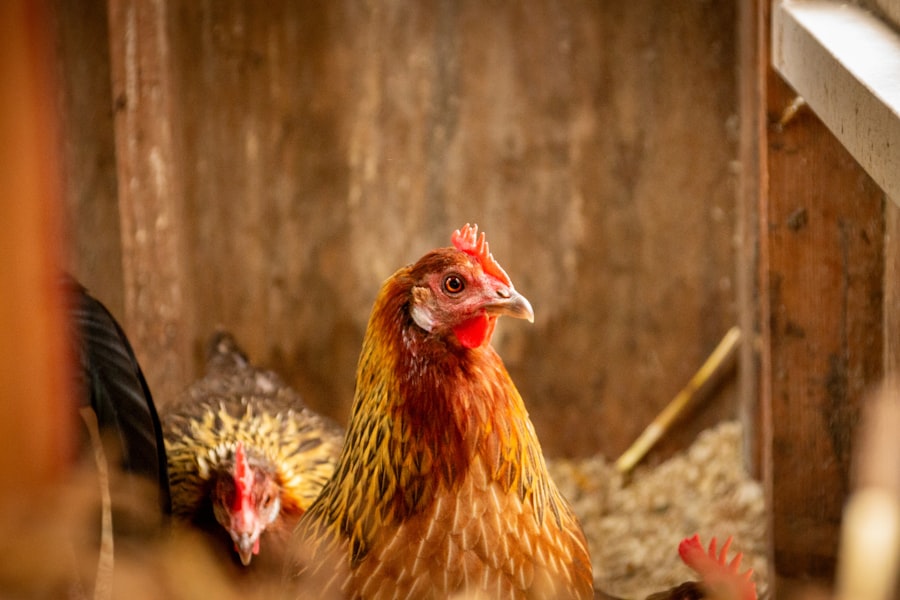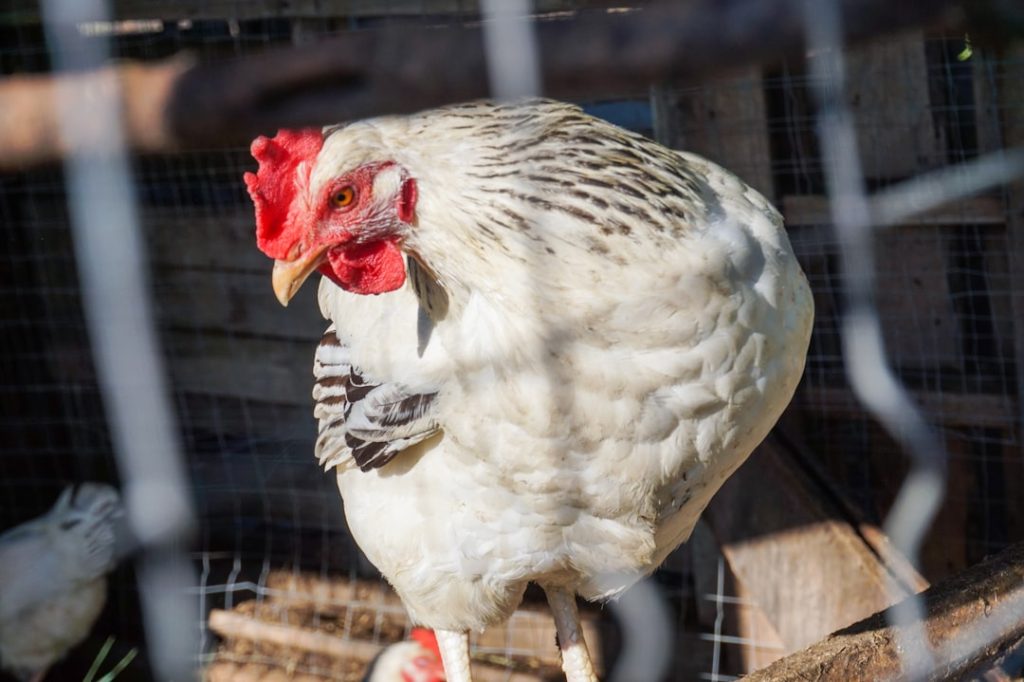Cats are natural predators that can pose a significant threat to chickens. Their hunting instincts drive them to pursue small animals, including poultry. Cats’ agility, stealth, and climbing abilities enable them to access chicken coops and runs easily.
Their persistence as hunters makes them a constant danger to chickens, even after unsuccessful attempts. Cats can also transmit diseases to chickens through parasites and bacteria. The stress of being hunted by cats can weaken chickens’ immune systems, making them more susceptible to illnesses.
This poses a health risk not only to individual birds but to the entire flock. Chicken owners should be aware of these potential dangers and implement protective measures to safeguard their flocks from cat predation and associated health risks. Securing coops and runs, as well as monitoring for signs of cat presence, are essential steps in maintaining the safety and well-being of chickens.
Table of Contents
- 1 Securing the Coop: Implementing Physical Barriers to Keep Cats Out
- 2 Creating Safe Outdoor Spaces: Designing Chicken Runs to Minimize Cat Access
- 3 Utilizing Deterrents: Using Scents and Sounds to Repel Cats from Chicken Areas
- 4 Supervising Free Range Time: Monitoring Chickens When They are Allowed to Roam
- 5 Training Cats: Teaching Felines to Stay Away from Chicken Enclosures
- 6 Seeking Professional Help: Consulting with Veterinarians or Animal Behaviorists for Additional Advice
- 7 FAQs
- 7.1 What are the potential dangers of cats to chickens?
- 7.2 How can I keep my chickens safe from cats?
- 7.3 Are there any deterrents that can be used to keep cats away from chickens?
- 7.4 Should I supervise my chickens when they are free-ranging to protect them from cats?
- 7.5 What should I do if I encounter a cat that is threatening my chickens?
Key Takeaways
- Cats pose a threat to chickens and can cause harm or stress to the birds.
- Physical barriers such as fences and netting can help keep cats out of chicken coops.
- Designing chicken runs with overhead cover and secure fencing can minimize cat access.
- Scents like citrus or lavender, and sounds like wind chimes can deter cats from chicken areas.
- Supervising chickens during free range time can help ensure their safety from cats.
Securing the Coop: Implementing Physical Barriers to Keep Cats Out
Implementing Physical Barriers
One of the most effective ways to safeguard chickens from cats is by installing physical barriers to prevent them from accessing the coop and run. This can be achieved by erecting sturdy fencing around the perimeter of the coop and run, ensuring it is tall enough to prevent cats from jumping over it and buried deep enough into the ground to prevent them from digging underneath it.
Securing the Coop and Run
In addition to fencing, adding a roof or netting over the top of the run can further deter cats from entering the area. It is crucial to ensure that all entry points are secure by checking for any gaps or holes in the coop or run that cats could use to gain access. Regular inspections of the coop and run are necessary to identify any signs of wear and tear that could compromise its security.
Maintaining a Secure Environment
Using heavy-duty locks on doors and windows can further prevent cats from entering the coop. Moreover, it is essential to keep the area around the coop clear of any potential hiding spots for cats. This involves removing any overgrown vegetation or debris that could provide cover for cats as they approach the coop. By implementing these physical barriers and securing the coop, chicken owners can significantly reduce the risk of cats posing a threat to their flock.
Creating Safe Outdoor Spaces: Designing Chicken Runs to Minimize Cat Access

Designing chicken runs with cat-proofing in mind is essential for keeping chickens safe from feline predators. When creating outdoor spaces for chickens, it is important to consider the layout and design in order to minimize cat access. One effective strategy is to design runs with multiple levels or platforms, as this can make it more difficult for cats to navigate and access the chickens.
Additionally, incorporating obstacles such as rocks or logs into the run can create barriers that deter cats from entering. Another important consideration when designing chicken runs is the use of materials that are difficult for cats to climb or scratch through. Using smooth materials such as metal or plastic for fencing can make it challenging for cats to gain a foothold and climb into the run.
Additionally, adding a layer of wire mesh around the bottom of the run can prevent cats from digging underneath and gaining access. Furthermore, creating safe outdoor spaces for chickens also involves providing ample hiding spots and shelters within the run. This can give chickens a place to retreat if they sense danger from cats, as well as make it more difficult for cats to locate and access the birds.
By carefully designing chicken runs with these considerations in mind, chicken owners can create safe outdoor spaces that minimize cat access and protect their flock.
Utilizing Deterrents: Using Scents and Sounds to Repel Cats from Chicken Areas
In addition to physical barriers, utilizing deterrents such as scents and sounds can be an effective way to repel cats from chicken areas. Cats are known for their sensitive sense of smell, and certain scents can be highly effective at deterring them from entering chicken coops and runs. For example, citrus scents such as lemon or orange can be off-putting to cats and can be used as a natural deterrent.
Spraying citrus-scented sprays around the perimeter of the coop and run can help discourage cats from approaching. Another effective deterrent is the use of motion-activated sound devices that emit high-frequency sounds that are unpleasant for cats. These devices can be strategically placed around the coop and run to emit a loud noise when they detect motion, scaring off any approaching cats.
Additionally, wind chimes or other noise-making objects can be hung around the perimeter of the coop to create a constant sound that can deter cats from entering. It is important to regularly refresh and rotate deterrents in order to prevent cats from becoming accustomed to them. By using a combination of scents and sounds, chicken owners can create an environment that is unappealing to cats and reduce the risk of them posing a threat to their flock.
Supervising Free Range Time: Monitoring Chickens When They are Allowed to Roam
Allowing chickens free range time can be beneficial for their well-being, but it is important for chicken owners to closely monitor them during this time in order to protect them from potential threats such as cats. When chickens are allowed to roam freely, they are more vulnerable to predators, including cats. It is important for chicken owners to supervise free range time in order to ensure the safety of their flock.
One effective strategy for supervising free range time is using designated chicken-friendly areas that have been thoroughly cat-proofed. This can include using portable fencing or netting to create a secure area where chickens can roam without being at risk from cats. By confining free range time to these designated areas, chicken owners can better monitor their flock and reduce the risk of cat attacks.
Additionally, using visual deterrents such as scarecrows or reflective objects in free range areas can help deter cats from approaching. These visual deterrents can make cats think twice about entering an area where chickens are present, reducing the risk of an attack. By closely supervising free range time and implementing these strategies, chicken owners can provide their flock with opportunities for outdoor activity while minimizing the risk of cat predation.
Training Cats: Teaching Felines to Stay Away from Chicken Enclosures

Positive Reinforcement Techniques
Training cats can be an effective way to keep them away from chicken enclosures. By using positive reinforcement techniques, such as rewarding cats for staying away from chicken areas, it is possible to train them to avoid these spaces. For example, providing treats or toys in areas away from chicken enclosures when cats exhibit good behavior can help reinforce this behavior.
Deterrents and Consistency
Another effective training technique is using deterrents such as water sprays or noise-making devices when cats approach chicken areas. By associating these negative experiences with attempting to access chicken enclosures, it is possible to train cats to stay away from these spaces. Consistency is key when training cats, and it may take time and patience before they learn to avoid chicken areas.
Ongoing Effort and Reinforcement
It is important for chicken owners to understand that training cats requires ongoing effort and reinforcement in order to be effective. By using positive reinforcement techniques and consistent training methods, it is possible to teach cats to stay away from chicken enclosures and reduce the risk of them posing a threat to the flock.
Seeking Professional Help: Consulting with Veterinarians or Animal Behaviorists for Additional Advice
In some cases, seeking professional help from veterinarians or animal behaviorists may be necessary in order to address cat predation issues in a chicken flock. Veterinarians can provide valuable insight into potential health risks posed by cats and recommend preventative measures that can protect chickens from diseases transmitted by feline predators. Additionally, veterinarians can offer advice on managing cat populations in areas where they pose a threat to chickens.
Animal behaviorists specialize in understanding animal behavior and can provide valuable advice on how to deter cats from accessing chicken areas. They can offer insights into cat behavior and recommend effective strategies for training them to stay away from chicken enclosures. By consulting with professionals in these fields, chicken owners can gain valuable knowledge and guidance on how best to protect their flock from cat predation.
Furthermore, seeking professional help can also provide support for addressing any underlying issues that may be contributing to cat predation problems. Veterinarians and animal behaviorists can offer personalized advice based on individual circumstances and provide tailored solutions that address specific challenges faced by chicken owners. By seeking professional help, chicken owners can gain valuable support in protecting their flock from cat predation and ensure the well-being of their birds.
If you’re looking for ways to keep your chickens safe from cats, you may also be interested in learning about the benefits of using an A-frame chicken coop. This type of coop provides a secure and elevated space for your chickens to roost and lay eggs, keeping them out of reach from potential predators like cats. Check out this article on A-Frame Chicken Coop to learn more about how it can help protect your flock.
FAQs
What are the potential dangers of cats to chickens?
Cats are natural predators and may pose a threat to chickens, especially young chicks. They may attack, injure, or even kill chickens.
How can I keep my chickens safe from cats?
To keep chickens safe from cats, it’s important to secure the chicken coop with sturdy fencing and ensure that there are no gaps or openings that cats can squeeze through. Additionally, providing a secure and elevated roosting area for the chickens can help keep them safe from potential cat attacks.
Are there any deterrents that can be used to keep cats away from chickens?
There are several deterrents that can be used to keep cats away from chickens, such as motion-activated sprinklers, ultrasonic devices, or natural repellents like citrus peels or coffee grounds. It’s important to regularly check and maintain these deterrents to ensure their effectiveness.
Should I supervise my chickens when they are free-ranging to protect them from cats?
Supervising chickens when they are free-ranging can help protect them from potential cat attacks. Keeping an eye on the chickens and being present to scare off any cats that may approach can help keep the chickens safe.
What should I do if I encounter a cat that is threatening my chickens?
If you encounter a cat that is threatening your chickens, it’s important to scare the cat away by making loud noises, throwing objects near the cat (not at the cat), or using a water hose to deter the cat. It’s important to ensure the safety of both the chickens and the cat in these situations.
Meet Walter, the feathered-friend fanatic of Florida! Nestled in the sunshine state, Walter struts through life with his feathered companions, clucking his way to happiness. With a coop that’s fancier than a five-star hotel, he’s the Don Juan of the chicken world. When he’s not teaching his hens to do the cha-cha, you’ll find him in a heated debate with his prized rooster, Sir Clucks-a-Lot. Walter’s poultry passion is no yolk; he’s the sunny-side-up guy you never knew you needed in your flock of friends!







